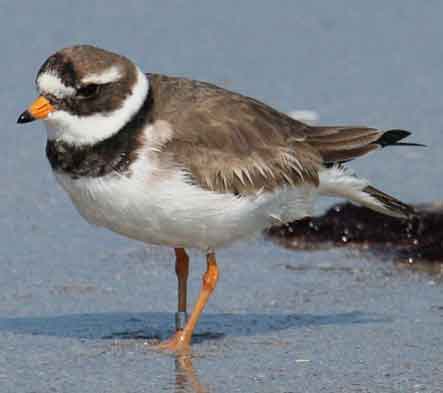
Charadrius hiaticula (*)
Superregnum: Eukaryota
Regnum: Animalia
Subregnum: Eumetazoa
Cladus: Bilateria
Cladus: Nephrozoa
Superphylum: Deuterostomia
Phylum: Chordata
Cladus: Craniata
Subphylum: Vertebrata
Infraphylum: Gnathostomata
Superclassis: Tetrapoda
Cladus: Reptiliomorpha
Cladus: Amniota
Classis: Reptilia
Cladus: Eureptilia
Cladus: Romeriida
Subclassis: Diapsida
Cladus: Sauria
Infraclassis: Archosauromorpha
Cladus: Crurotarsi
Divisio: Archosauria
Subsectio: Ornithodira
Subtaxon: Dinosauromorpha
Cladus: Dinosauria
Ordo: Saurischia
Cladus: Theropoda
Cladus: Neotheropoda
Infraclassis: Aves
Cladus: Euavialae
Cladus: Avebrevicauda
Cladus: Pygostylia
Cladus: Ornithothoraces
Cladus: Euornithes
Cladus: Ornithuromorpha
Cladus: Ornithurae
Cladus: Carinatae
Parvclassis: Neornithes
Cohors: Neognathae
Ordo: Charadriiformes
Subordo: Charadrii
Familia: Charadriidae
Genus: Charadrius
Species: Charadrius hiaticula
Subspecies: C. h. hiaticula – C. h. psammodromus – C. h. tundrae
Name
Charadrius hiaticula Linnaeus, 1758
Synonyms
Charadrius hiaticulus (orth. err.)
Aegialitis hiaticula
References
Linnaeus, C. 1758. Systema Naturae per regna tria naturæ, secundum classes, ordines, genera, species, cum characteribus, differentiis, synonymis, locis, Tomus I. Editio decima, reformata. Holmiæ: impensis direct. Laurentii Salvii. i–ii, 1–824 pp DOI: 10.5962/bhl.title.542: 150. Reference page.
Vernacular names
Afrikaans: Ringnekstrandkiewiet
العربية: رسول الغيث المطوق
asturianu: Mazaricu de Collar
azərbaycanca: Yaxalı bozca
беларуская: Гальштучнік
български: Пясъчен дъждосвирец
বাংলা: পাতি নথজিরিয়া
brezhoneg: Nouelig bras
català: Corriol gros
kaszëbsczi: Wãdzôrz
čeština: Kulík písečný
Cymraeg: Cwtiad Torchog
dansk: Stor præstekrave
Deutsch: Sandregenpfeifer
ދިވެހިބަސް: އަނގޮޓި ބޮނޑަނަ
Ελληνικά: Αμμοπλουμίδι
English: Common Ringed Plover
Esperanto: Kolumpluvio
español: Chorlitejo Grande
eesti: Liivatüll
euskara: Txirritxo handi
فارسی: سلیم طوقی
suomi: Tylli
føroyskt: Svarthálsa
Nordfriisk: Groonk
français: Pluvier grand-gravelot
Frysk: Bûnte wilster
Gaeilge: Feadóg an fhainne
Gàidhlig: Bòdhag
galego: Píllara real
Gaelg: Feddag Ainit
עברית: חופמי צוארון
hrvatski: Kulik blataric
magyar: Parti lile
հայերեն: Փողկապավոր քարադր
íslenska: Sandlóa
italiano: Corriere grosso
ᐃᓄᒃᑎᑐᑦ/inuktitut: Kudlekaleak
日本語: ハジロコチドリ
ქართული: საყელოიანი წინტალა
қазақша: Шүрілдек торғай
한국어: 흰죽지꼬마물떼새
Lëtzebuergesch: Grousse Wakeleefer
lietuvių: Jūrinis kirlikas
latviešu: Smilšu tārtiņš
македонски: Среден пескар
മലയാളം: വലിയ മോതിരക്കോഴി
монгол: Хиазат сүвээ цагаан - ᠬᠦᠵᠣᠬᠦᠪᠴᠢᠲᠣ ᠬᠢᠵᠠᠲᠣ
Bahasa Melayu: Burung Rapang Gelang Besar
Malti: Monakella prima
Nederlands: Bontbekplevier
norsk nynorsk: Sandlo
norsk: Sandlo
polski: Sieweczka obrożna
پنجابی: چکردار پلوور
português do Brasil: Batuíra-de-bando
português: Borrelho-grande-de-coleira
rumantsch: Gravarel grond
română: Prundăraş gulerat mare
русский: Галстучник
davvisámegiella: Buvvedat
slovenčina: Kulík piesočný
slovenščina: Komatni deževnik
shqip: Vraponjësi i madh
српски / srpski: Žalar blataric - Жалар блатарич
svenska: Större strandpipare
Kiswahili: Kitwitwi Mkufu-mweusi
ไทย: นกหัวโตเล็กขาส้ม
Türkçe: Kolyeli büyük yağmurcun
українська: Пісочник великий
Tiếng Việt: Choi choi mỏ dài
isiXhosa: Unokrekre
中文: 剑鸻
The common ringed plover or ringed plover (Charadrius hiaticula) is a small plover that breeds in Arctic Eurasia. The genus name Charadrius is a Late Latin word for a yellowish bird mentioned in the fourth-century Vulgate. It derives from Ancient Greek kharadrios a bird found in ravines and river valleys (kharadra, "ravine"). The specific hiaticula is Latin and has a similar meaning to the Greek term, coming from hiatus, "cleft" and -cola, "dweller" (colere, "to dwell").[2]
File:Common ringed plover.webmPlay media
Common ringed plover foraging at the shoreline.
Description
Adults are 17–19.5 cm (6.7–7.7 in) in length with a 35–41 cm (14–16 in) wingspan. They have a grey-brown back and wings, a white belly, and a white breast with one black neckband. They have a brown cap, a white forehead, a black mask around the eyes and a short orange and black bill. The legs are orange and only the outer two toes are slightly webbed, unlike the slightly smaller but otherwise very similar semipalmated plover, which has all three toes slightly webbed, and also a marginally narrower breast band; it was in former times included in the present species. Juvenile ringed plovers are duller than the adults in colour, with an often incomplete grey-brown breast band, a dark bill and dull yellowish-grey legs.
This species differs from the smaller little ringed plover in leg colour, the head pattern, and the lack of an obvious yellow eye-ring.
Breeding, range and habitat
The common ringed plover's breeding habitat is open ground on beaches or flats across northern Eurosiberia and in Arctic northeast Canada. Some birds breed inland, and in western Europe they nest as far south as northern France. They nest on the ground in an open area with little or no plant growth.
If a potential predator approaches the nest, the adult will walk away from the scrape, calling to attract the intruder and feigning a broken wing. Once the intruder is far enough from the nest, the plover flies off.
Common ringed plovers are migratory and winter in coastal areas south to Africa. In Norway, geolocators have revealed that adult breeding birds migrate to West Africa.[3] Many birds in Great Britain and northern France are resident throughout the year.
Feeding
These birds forage for food on beaches, tidal flats and fields, usually by sight. They eat insects, crustaceans and worms.
Subspecies
There are three weakly defined subspecies,[4] which vary slightly in size and mantle colour; they intergrade where their ranges meet:
C. h. psammodroma – Salomonsen, 1930: breeds in Iceland, Greenland, northeast Canada; winters in west Africa. It is intermediate in size and colour.
C. h. hiaticula – Linnaeus, 1758: breeds from temperate western Europe north to central Scandinavia; resident or short-distance migrant to southwest Europe. It is the largest and palest subspecies.
C. h. tundrae – (Lowe, 1915): breeds in Arctic northern Scandinavia and Asiatic Russia; winters in Africa and southwest Asia. It is the smallest and darkest subspecies.
C. h. hiaticula and C. h. tundrae are among the taxa to which the Agreement on the Conservation of African-Eurasian Migratory Waterbirds (AEWA) applies.
References
BirdLife International (2019). "Charadrius hiaticula". IUCN Red List of Threatened Species. 2019: e.T22693759A155487854. doi:10.2305/IUCN.UK.2019-3.RLTS.T22693759A155487854.en. Retrieved 18 November 2021.
Jobling, James A (2010). The Helm Dictionary of Scientific Bird Names. London: Christopher Helm. pp. 99, 191. ISBN 978-1-4081-2501-4.
Lislevand, T.; Briedis, M.; Heggøy, O.; Hahn, S. (2017). "Seasonal migration strategies of Common Ringed Plovers Charadrius hiaticula". Ibis. 159 (1): 225–229. doi:10.1111/ibi.12424.
Gill, Frank; Donsker, David, eds. (2019). "Grebes, flamingos, buttonquail, plovers, painted-snipes, jacanas, plains-wanderer, seedsnipes". World Bird List Version 9.2. International Ornithologists' Union. Retrieved 26 June 2019.
Retrieved from "http://en.wikipedia.org/"
All text is available under the terms of the GNU Free Documentation License

